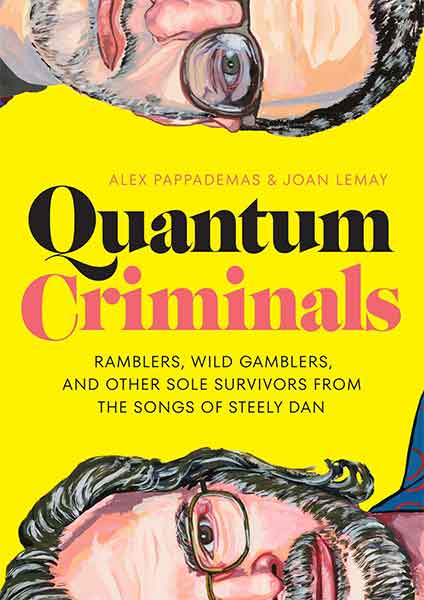
Quantum Criminals, Alex Pappademas & Joan LeMay
(University of Texas Press, hbck, 268pp)
The difference between US and UK book cover design has always been strange. For a while my publishing operation Stride used an American illustrator and the UK reps and bookshops hated his work whilst the Americans lapped them up. I’m afraid I’m not at all keen on Joan LeMay’s illustrations here: they’re like amateur comic book illustrations, especially the many floating heads which have a crude red line drawn round them.
In a way, however, they suit the whole awkward smartarse concept of the book. Subtitled ‘Ramblers, Wild Gamblers, and other Sole Survivors from the Songs of Steely Dan’, Quantum Criminals is hung on the characters who populate Steely Dan songs (and to a lesser extent, the musicians who played them). It’s a nice idea, but one that doesn’t quite work. You see, Donald Fagen and Walter Becker – who basically were Steely Dan – enjoyed writing dense, obscure and elusive lyrics, and then making up shit about it for journalists. Not to mention being obsessive audiophiles, as well as studio and production fetishists who scrapped hours of work by session guitarists, and massive consumers of alcohol, cigarettes and mind-bending drugs.
So, to rely on the composers of the songs is as unsound as it always is, especially when their statements and interviews were renowned for being deliberately obscurist and diversionary; jokey and entertaining for sure, but you wouldn’t believe anything they say. Nor would you buy a used car from either of them, trust them an inch, or take them home to meet your parents.
Pappademas has, of course, rounded up a mass of material about the band, which is referenced at the back of the book as notes for each chapter (unfortunately, there’s no bibliography included here; no index either) but in the main it is music press stuff rather than books, musical criticism or cultural studies he draws on. Sometimes he seems out to prove that so-and-so, named in the song is based on this or that character, at other times he simply turns to storytelling, riffing on a phrase, image or idea that Fagen & Becker have thrown out somewhere along the way.
This is, of course, all fun stuff. It’s readable and entertaining, but I’m not sure it tells me much that I don’t know already about Steely Dan, having read the same music press stuff and several books about the band that are available. It certainly doesn’t really get to grips with their obsessiveness in the studio and later move towards a more relaxed touring model, nor many of their characters’ unpleasant inclinations towards underage sex, pimping, larceny and blackmail, or even the band’s ‘feud’ with The Eagles. Yes, these all get mentioned, but Pappademas neatly sidesteps round the issues, despite there being real questions to answer.
Many people regard later Steely Dan as soft rock affiliates of The Eagles, smooth operators writing muzak for FM radio (look it up kids) and it would be good to have explored the musical subversion that I believe lurks under the musical gloss. Although Pappademas states that ‘the solos are the most famously overdetermined parts of Steely Dan’s songs’, I’m not sure that
they are the one moment in a Steely Dan song where the deeper
feeling of the song is allowed to break free of its tightly composed
and arranged frame, the one time a player is permitted to step
outside the constraints of the track, breaking through the constraints
of anonymized slickness this band used to such brilliant rhetorical
effect.
I don’t think Steely Dan’s music is ‘anonymized slickness’, it has a depth that takes time to reveal it’s textures and intricacies; and to suggest that it’s only the solos which somehow break free, is a nonsense, as is talk about feelings. The last twenty years of the band live (although it’s now more of a Donald Fagen big band) show that the songs work as songs, however they are rearranged, extended, dissected or deconstructed. The fact that the live versions don’t try and reproduce the studio originals evidences the songs’ strengths, which often shone through on albums despite the (over-)production.
I’m not a musician, so I’m not looking for technical analysis of Steely Dan songs, but the whole New York and then LA and then NYC again context for this music – dirty city streets, drugs and violence vs. drugs, freeways and sunshine – seems as important as the characters in the songs. These are the worlds the band inhabited, often alien ones to us in the UK (though I’ve been to both), and also now part of recent history. I’d like to have seen more about musical influences, some close reading of lyrics, and some writing that situates the band critically, culturally and musically. Jazz was a thing, jazz-rock was a thing, singersongwriting was a thing, blues was a thing, so how did it all (and much else) combine to produce Steely Dan?
As I said earlier, this book is hugely entertaining and eminently readable. But it could have been better. Some photos would have been nice, as would more about personification and characterization, an exploration of the contrast between lyrical content and musical form (seedy vs polished), and a bit less authorial attitude and presence. The real problem I think is an aside on page 163, where Pappademas states that he is ‘pretty sure I could watch Donald and Walter snicker at rejected solos for at least three hours.’ That’s not natural! – the albums are where it’s at, the songs are what Steely Dan is about. The rest is all background noise.
.
Rupert Loydell
.
